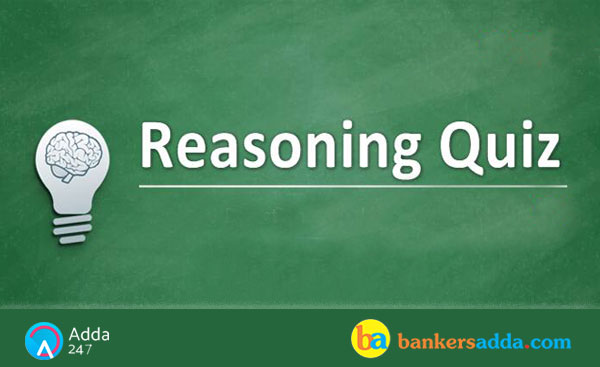Reasoning Ability is an onerous section. With the increasing complexity of questions, it becomes hard for one to give it the cold shoulder. The only way to make the grade in this particular section in the forthcoming banking exams like Indian Bank PO Mains is to practice continuously with all your heart and soul. And, to let you practice with the best of the latest pattern questions, here is the Adda247 Reasoning Quiz based on the exact same pattern of questions that are being asked in the exams.
Directions (1-5): Study the following information carefully and answer the question given below-
Six employees i.e. P, B, Z, M, O and G of a company are going to office on different days of same week. This week period start from Wednesday to Tuesday. One day in between of this week is holiday. They have different bikes i.e. Fuoco, Avenger, Ducati, Thunderbolt, Suzuki and Honda but not necessary in same order. They are using their own bikes to go to office. P is going to office just after holiday via Suzuki bikes. The one who is going to office on Tuesday is using Avenger bike. M is going to office just after the one who is using Ducati bike but not after holiday. There is one day gap between P and O who is using Fuoco. B is going to office after holiday. G does not have Ducati bike but he is going to office after the day on which the one who is using Thunderbolt. The one who is using Honda is not going to office after holiday. O is not going to office just after and before G.
Q1. Who among the following is using Thunderbolt bike?
Q2. Who among the following is going to office on Wednesday?
Q3. How many employees are going to office before holiday?
Q4. Who among the following is using Avenger bike?
Q5. Who among the following is going to office on Sunday?
Q6. When income tax rates are reduced, there is an increase in total income tax revenues for the Government. Which of the following is analogous to the argument above in terms of its logical features?
Q7. Impressions are direct, vivid, and forceful products of immediate experience; ideas are merely feeble copies of these original impressions. Assuming the above statement is true, which of the statements logically follow from it? I. Every impression leads to an idea. II. Ideas must follow an antecedent impression. III. The colour of the 2011 XAT test booklet right in front of a candidate is an impression to her, whereas the memory of the colour of her television set is an idea. IV. If one was interested in the origin of the idea of the colour of a television set, then one need to understand the impressions from which this idea was derived.
Q8. Alfredo, Diego and Lionel are discussing Argentinean football. Alfredo: Argentina was a football powerhouse. Diego: Argentina is a football powerhouse. Lionel: Argentina will be a football powerhouse. Which of the following cannot be inferred from the above conversation?
Q9. Ethologists, people who study animal behaviour, have traditionally divided an organism's actions into two categories: learned behaviour (based on experience) and instinctive behaviour (based on genotype). Some current scholars reject this distinction, claiming that all behaviour is a predictable interaction of experience and genotype. Which of the following, if true, most strengthens the arguments made in the sentence above?
Q10. The Civic administration has asked the residents of the dilapidated buildings to move out as these buildings will be demolished within the next thirty days Assumptions: I. The Civic administration may be able to demolish these buildings as per schedule. II. The residents of these buildings may vacate and stay elsewhere
Directions (11-15): In each question below are given three statements followed by four conclusions numbered I, II, III and IV. You have to take the given statements to be true even if they seem to be at variance with commonly known facts. Read all the conclusions and then decide which of the given conclusions logically follows from the given statements, disregarding commonly known facts.
Q11. Statements:
I. No lappy are books.
II. All books are copy.
III. All copy are pens.
Conclusions:
I. No lappy are copy.
II. No lappy are pens.
III. Some copy are not books.
IV. Some pens are not books.
Q12. Statements:
I. Some bus are truck.
II. Some truck are cars.
III. Some cars are trains.
Conclusions:
I. No bus are trains.
II. No cars are bus.
III. Some truck are trains.
IV. Some cars are bus.
Q13. Statements:
I. Some cats are dogs.
II. All dogs are rats.
III. Some Rats are fox.
Conclusions:
I. Some cats are fox.
II. Some dogs are fox.
III. Some rats are not cats.
IV. Some rats are not fox.
Q14. Statements:
I. No Delhi are Goa.
II. No Goa are Chennai.
III. All Chennai are Pune.
Conclusions:
I. No Goa are Delhi.
II. Some Goa are not Chennai.
III. Some Chennai are Pune.
IV. Some Pune are Chennai.
Q15. Statements:
I. Some Lucknow are UP.
II. All MP are Lucknow.
III. All Delhi are MP.
Conclusions:
I. Some UP are Lucknow.
II. All Delhi are Lucknow.
III. Some Lucknow are not Delhi.
IV. All Lucknow are Delhi.






 GA Capsule for SBI Clerk Mains 2025, Dow...
GA Capsule for SBI Clerk Mains 2025, Dow...
 The Hindu Review October 2022: Download ...
The Hindu Review October 2022: Download ...
 How to Make the Most of Mock Tests for R...
How to Make the Most of Mock Tests for R...





